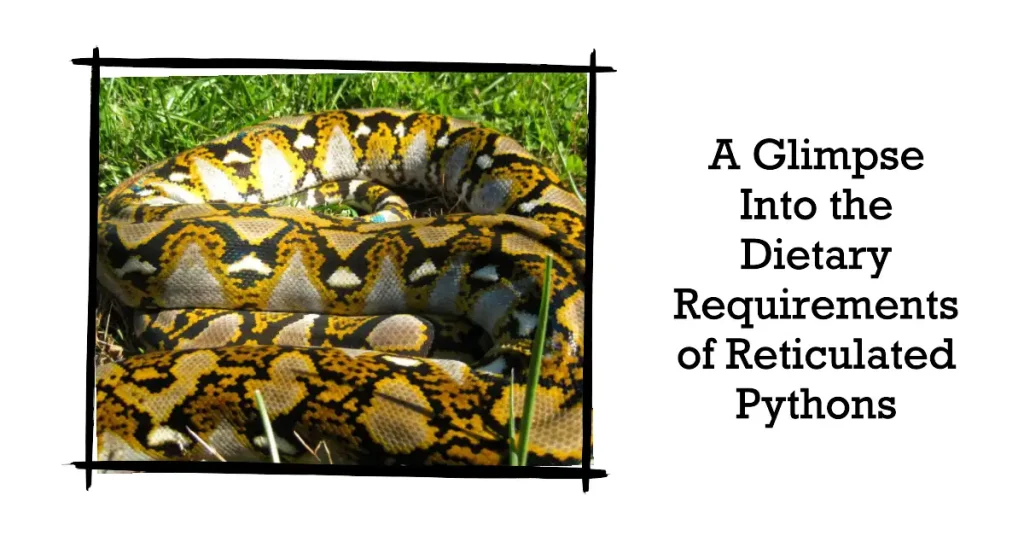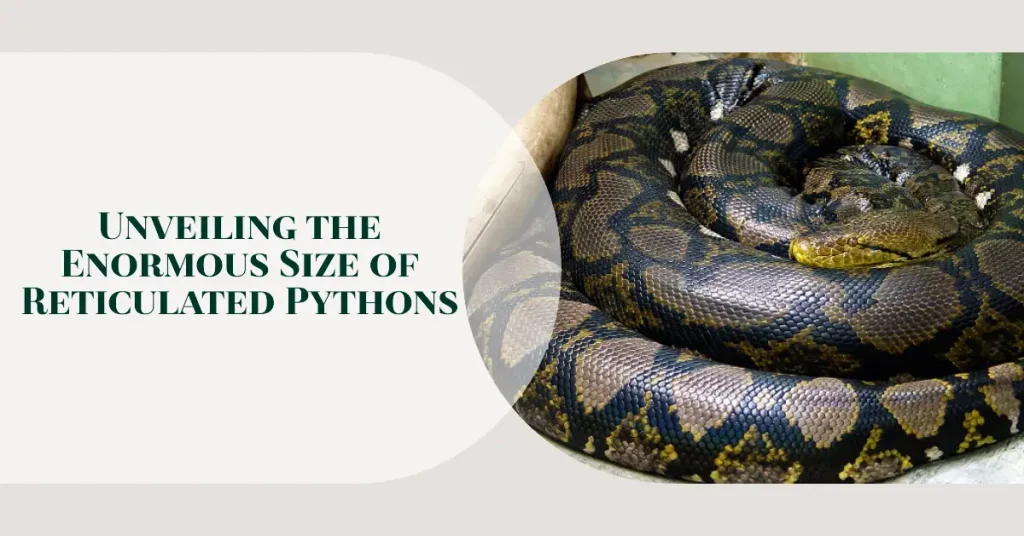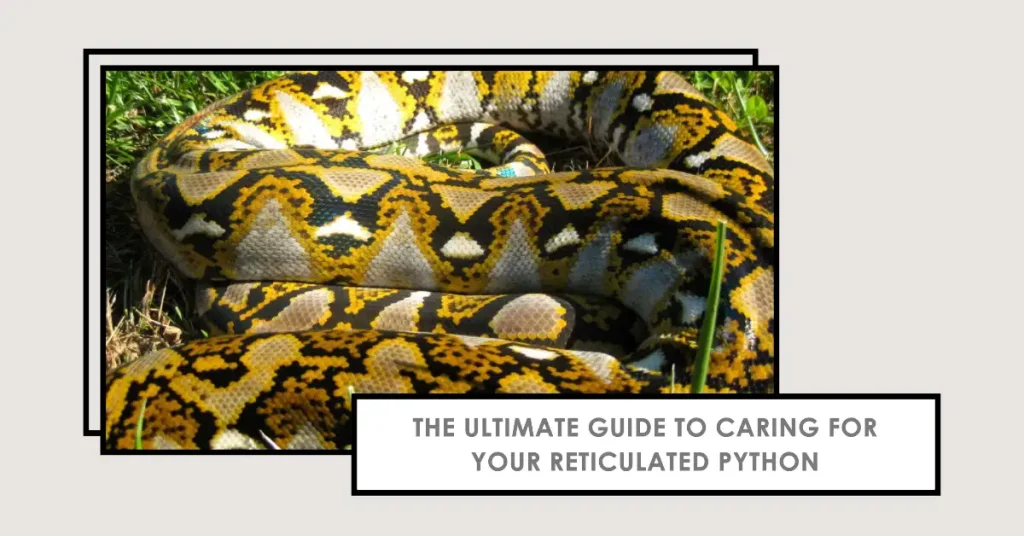I have researched and studied the feeding habits of reticulated pythons extensively. In this article, I aim to provide a comprehensive guide on the reticulated python diet.
Understanding the natural diet and feeding habits of these snakes is crucial for maintaining their health and well-being in captivity. The reticulated python is one of the largest snakes in the world, and as such, proper nutrition is essential for their growth and longevity.
Throughout this article, we will explore the feeding habits and preferences of reticulated pythons, discuss the optimal food choices and portion sizes, and outline their specific nutritional needs. By following the guidelines provided in this comprehensive feeding guide, you can ensure your reticulated python has a healthy and satisfying diet.
Key Takeaways
- The reticulated python is one of the largest snakes in the world.
- Understanding their natural diet and feeding habits is crucial for their health and well-being in captivity.
- Providing a balanced and varied diet is essential for meeting their nutritional needs.
Feeding Habits of Reticulated Pythons
Understanding the natural feeding habits of reticulated pythons is essential to providing a suitable diet in captivity. In the wild, reticulated pythons are opportunistic predators that will consume a wide range of prey, including mammals, birds, and reptiles.
These snakes utilize a “sit and wait” hunting technique, where they will remain motionless for extended periods, waiting for prey to approach. Once prey is detected, the reticulated python will strike with great speed and force, using their sharp teeth to grasp and hold onto the prey.
Due to their large size and strength, reticulated pythons are capable of taking down some of the largest prey animals in their environment, including deer and wild pigs. However, they also consume smaller prey, such as rodents and birds, when larger prey is scarce.
Prey Preferences
While reticulated pythons are capable of consuming a variety of prey animals, they do have some preferences. In general, they tend to favor warm-blooded prey, such as mammals and birds, over cold-blooded prey, such as reptiles and amphibians.
They also tend to prefer prey that can be swallowed whole, and will often consume animals that are larger than their own body size. This is possible due to their incredible jaw flexibility and the ability to unhinge their jaws to accommodate prey that is several times their own girth.
Feeding Frequency
In the wild, reticulated pythons may only feed a few times a year, as large prey can sustain them for extended periods. However, in captivity, it is recommended to feed them more frequently, as a varied diet is essential to meeting their nutritional needs.
The frequency of feeding will vary depending on the age, size, and health of the snake, but as a general rule, juveniles should be fed every 7-10 days, while adults can be fed every 2-3 weeks.
Note: It’s important to note that reticulated pythons can become aggressive during feeding and should be handled with caution. They should also be fed in a separate enclosure to avoid the risk of accidental injury.
What Do Reticulated Pythons Eat?
Reticulated pythons are opportunistic feeders and can consume a wide variety of prey items, including mammals, birds, and reptiles.
In the wild, reticulated pythons are known to feed on prey such as rodents, monkeys, birds, and other snakes. They are also capable of taking down larger prey such as deer and pigs.
When kept in captivity, reticulated pythons should be offered a varied diet to ensure they receive a balanced nutritional intake. A diet consisting solely of rodents can lead to nutritional deficiencies, so it’s essential to supplement with other prey items.
Some suitable prey items for reticulated pythons in captivity include rabbits, guinea pigs, quail, and rats. It’s important to note that prey items should be of an appropriate size for the snake to consume without any difficulty.
Live prey should be avoided as it can be dangerous for the snake and may result in injury. Instead, pre-killed or properly thawed frozen prey should be offered.
It’s important to keep in mind that reticulated pythons have a high metabolism and require frequent feeding. Younger snakes may require feeding once a week, while adults may only require feeding once every two to three weeks. It’s crucial to monitor the snake’s weight and adjust feeding frequency accordingly.
Optimal Food for Reticulated Pythons
When it comes to the diet of reticulated pythons, it’s important to provide them with the most suitable prey items. Ideally, you want to feed them food that mimics what they would eat in the wild, while also ensuring they receive proper nutrition.
The size of the food item is crucial as overfeeding or underfeeding can lead to health issues. Juvenile pythons should be fed smaller prey items more frequently, while adult pythons can handle larger prey items with longer intervals between feeding.
Live prey can be dangerous for your snake as there is a risk of injury, so it’s recommended to feed pre-killed or properly thawed frozen prey. Additionally, it’s important to avoid feeding your snake wild-caught prey as they can carry diseases or parasites that can harm your snake.
What Prey Items to Feed Reticulated Pythons
Reticulated pythons are carnivorous and can consume a wide variety of prey items, including mammals, birds, and reptiles. However, it is important to avoid feeding them prey that is too large or too small for them to consume comfortably.
| Prey Type | Size of Prey Items |
|---|---|
| Mammals | Bunny, Guinea Pig, Rats, Birds |
| Birds | Quail, Pigeon, Chicken |
| Reptiles | Monitor Lizards, Snakes, Geckos, Frogs |
It’s recommended to vary the diet of your reticulated python, offering a variety of prey items to ensure they receive proper nutrition. However, it’s important to note that some prey items may be more nutritionally dense than others, so it’s important to research the specific nutritional requirements of your snake.
Supplementing their diet with vitamins and minerals can also ensure they receive all the necessary nutrients. However, it’s important to consult with a veterinarian or reptile nutritionist to ensure proper dosage and avoid over-supplementing, which can be harmful to your snake.
Dietary Requirements for Reticulated Pythons
As an owner of a reticulated python, it is important to understand their dietary requirements to maintain their health and well-being. These snakes are carnivores and require a diet rich in protein to support their growth and development.
Feeding frequency is dependent on the age and size of the snake. Young reticulated pythons typically require smaller and more frequent meals compared to adults. A general guideline for feeding frequency is once every 7-10 days for adults and once every 5-7 days for juveniles.
Portion size is also dependent on the size and age of the snake. Generally, prey items should be 15-25% of the snake’s body weight. It is important not to overfeed your snake as this can lead to obesity and other health problems.
In addition to a varied diet, reticulated pythons may require supplementation to ensure they receive all the necessary nutrients. Calcium is essential, and a lack of it may lead to metabolic bone disease. Therefore, it is important to provide proper supplements, including vitamin D3 and calcium powder.
Food Preferences of Reticulated Pythons
Understanding the food preferences of your reticulated python is crucial to ensure they are getting a balanced diet. Factors such as size, texture, and smell can influence their willingness to consume certain prey items. It’s important to keep in mind that individual preferences can vary. Some reticulated pythons may prefer live prey, while others may only eat frozen-thawed.
If you are introducing new food items, it’s best to do so gradually. Start with small amounts and observe their response. If they show interest, slowly increase the portion size over time. If your python is not interested in a particular prey item, try offering it again at a later time or consider offering a different type of prey.
It’s not uncommon for reticulated pythons to refuse food for extended periods, especially during breeding season or when they are shedding. If your python goes for an extended period without eating, it’s important to monitor their weight and overall health. If concerns arise, consult with a veterinarian.
Reticulated Python Nutritional Needs
Reticulated pythons have unique nutritional needs that must be met to ensure their health and well-being. As snake owners, we must strive to provide a balanced diet that includes all necessary vitamins, minerals, and other essential nutrients. Failure to meet their nutritional requirements can result in health issues, such as obesity, malnutrition, and metabolic bone disease.
One of the most critical nutritional needs of reticulated pythons is protein. They require a high protein diet for growth and energy. However, it’s important to balance their protein intake with other nutrients, such as calcium and phosphorus. These minerals are vital for maintaining healthy bones and muscle function. Feeding a diet that is high in protein and low in other nutrients can lead to health issues.
Another essential nutrient that reticulated pythons require is water. A lack of water can lead to dehydration, which can cause severe health problems. Snake owners should always provide fresh, clean water for their pets. It’s also important to ensure that their enclosure maintains proper humidity levels to prevent dehydration.
In addition to protein, calcium, phosphorus, and water, reticulated pythons require other essential vitamins and minerals, such as vitamin D and potassium. These nutrients are necessary for maintaining a healthy immune system, proper digestion, and overall growth and development. Feeding a balanced diet that includes a variety of prey items can help ensure that all necessary nutrients are being provided.
As responsible snake owners, we must pay close attention to our reticulated pythons’ nutritional needs and ensure that they are receiving a balanced diet. By feeding a variety of prey items and offering proper supplementation, we can help our snakes maintain excellent health and thriving growth.
Best Diet for Reticulated Pythons
Based on the information presented in this feeding guide, a well-balanced diet for reticulated pythons should consist of a variety of prey items to ensure they receive the necessary nutrients for optimal health and growth.
Prey items should be appropriately sized to avoid any feeding difficulties or potential harm to the snake. Smaller items can be offered more frequently, while larger items should be fed less frequently to prevent overfeeding or obesity.
Avoid feeding live prey, as this can endanger the snake and lead to serious injuries. Pre-killed or properly thawed frozen prey should always be used to minimize risks.
In addition to proper feeding, it’s important to supplement the diet of reticulated pythons with a high-quality reptile multivitamin and calcium powder. These supplements can help fill any nutritional gaps and promote healthy bone growth and development.
Owners can also consider feeding commercially available prey items, such as frozen mice or rats, to ensure their snake is receiving a well-rounded diet. Be sure to choose prey items that are appropriate for the size and age of the snake.
Following these guidelines and regularly monitoring the snake’s body condition and overall health can help ensure a balanced and satisfying diet for your reticulated python.
Conclusion
In conclusion, understanding the diet of reticulated pythons is crucial for keeping them healthy in captivity. As we have discussed, these snakes have a varied diet that includes mammals, birds, and reptiles. It is important to offer a varied diet to ensure proper nutritional balance. Providing optimal prey items that are of the appropriate size and type is also essential.
In addition, meeting the dietary requirements of reticulated pythons is critical for their growth and overall health. This includes feeding them on a recommended schedule, offering appropriate portion sizes, and supplementing their diet if necessary. Properly feeding pre-killed or thawed frozen prey can also minimize risks in feeding.
When introducing new food items to reticulated pythons, it is important to understand their food preferences and gradually introduce new prey items. Monitoring feeding habits and addressing any potential issues is also important.
By following the comprehensive feeding guide provided in this article, snake owners can ensure their reticulated pythons have a healthy and satisfying diet. Remember to always consult with a veterinarian or experienced reptile keeper for further advice on dietary needs and feeding practices.
FAQ
Q: What is the diet of reticulated pythons?
A: Reticulated pythons have a diet that mainly consists of mammals, birds, and reptiles.
Q: What are the feeding habits of reticulated pythons?
A: Reticulated pythons are known for their hunting techniques and prefer to consume whole prey items.
Q: What do reticulated pythons eat in the wild?
A: In the wild, reticulated pythons eat a variety of prey, including mammals, birds, and reptiles.
Q: What is the optimal food for reticulated pythons?
A: The optimal food for reticulated pythons includes appropriately sized prey items that are pre-killed or properly thawed frozen.
Q: What are the dietary requirements for reticulated pythons?
A: Reticulated pythons require a balanced diet that meets their nutritional needs, including the recommended frequency of feeding and portion sizes.
Q: What are the food preferences of reticulated pythons?
A: Reticulated pythons may have preferences for certain prey items and may require gradual introduction to new food items.
Q: What are the nutritional needs of reticulated pythons?
A: Reticulated pythons require a diet that includes the necessary vitamins, minerals, and other essential nutrients for their growth and overall health.
Q: What is the best diet for reticulated pythons?
A: The best diet for reticulated pythons includes a well-planned feeding strategy that incorporates commercially available prey items and proper supplementation.
Featured image: Kyle Zimmerman, CC BY-SA 4.0, via Wikimedia Commons


